DownTown Videos: Systems Development and Procurement Project Report
VerifiedAdded on 2020/04/21
|21
|4896
|113
Project
AI Summary
This project report details the development of a state-of-the-art system for DownTown Videos, aiming to automate movie and video game rentals. The project begins with an executive summary and background, highlighting the need for automation to overcome challenges in the current manual system. A literature review establishes the system's objectives, including improved customer interaction and real-time operations. The report outlines the resources, potential risks, and a detailed timeline using a Gantt chart. It then delves into the methodologies used, particularly agile and iterative approaches, with a focus on Extreme Programming. The project explores requirement collection techniques such as interviews, questionnaires, and prototypes. Functional and non-functional requirements are defined, followed by the creation of a Use Case Diagram and description. The report proposes a development methodology, including modeling techniques and tools. Finally, a class diagram is presented, and references are provided, offering a comprehensive overview of the system development process.
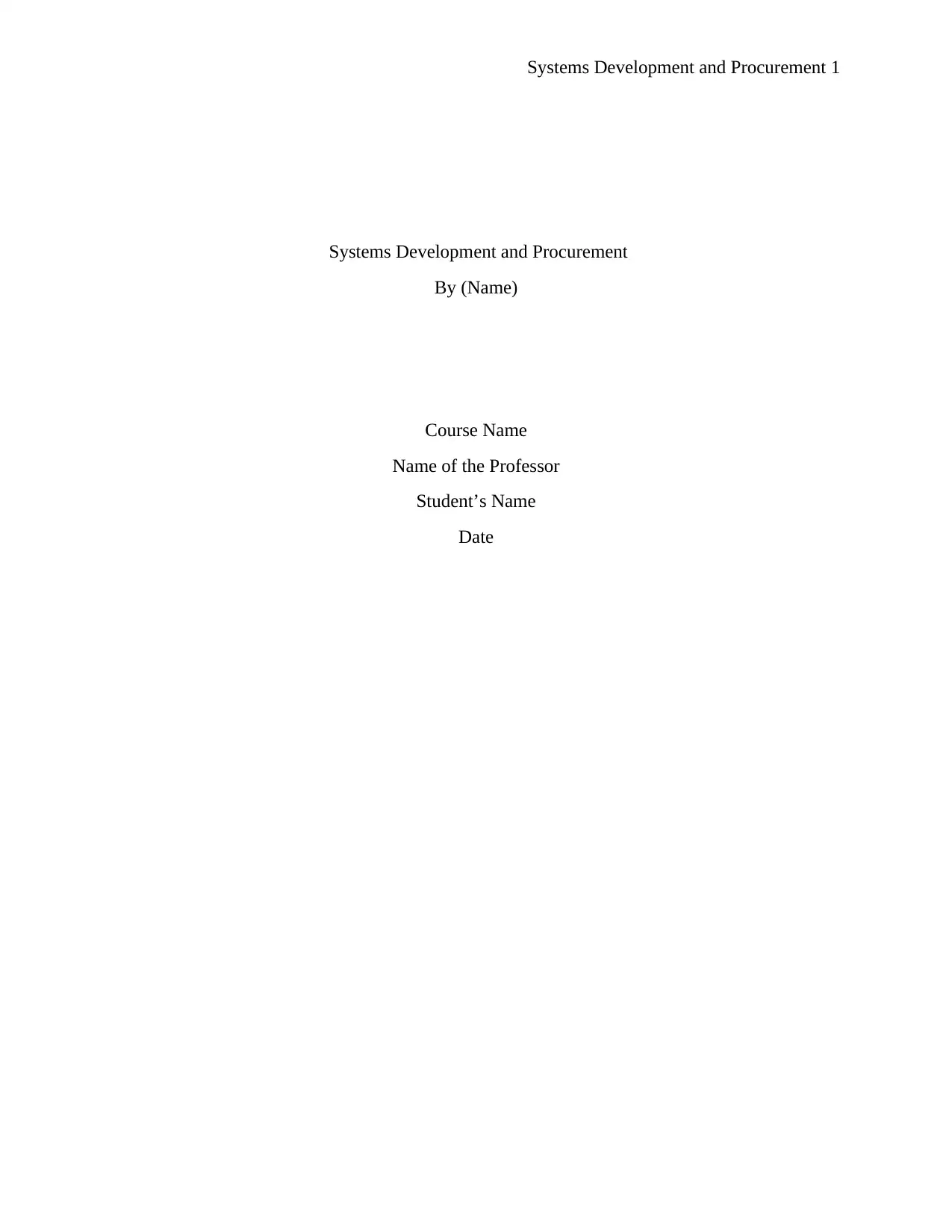
Systems Development and Procurement 1
Systems Development and Procurement
By (Name)
Course Name
Name of the Professor
Student’s Name
Date
Systems Development and Procurement
By (Name)
Course Name
Name of the Professor
Student’s Name
Date
Paraphrase This Document
Need a fresh take? Get an instant paraphrase of this document with our AI Paraphraser
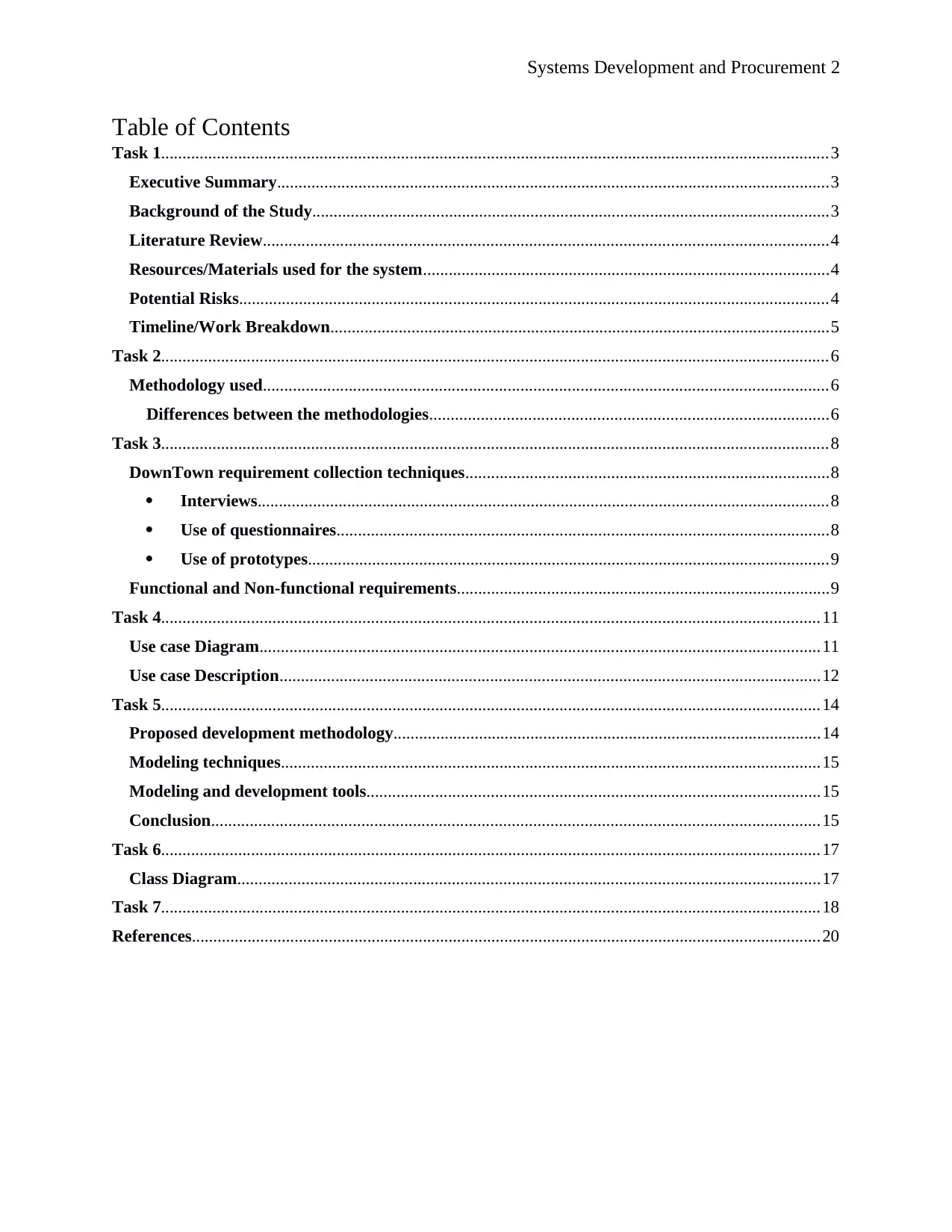
Systems Development and Procurement 2
Table of Contents
Task 1............................................................................................................................................................3
Executive Summary.................................................................................................................................3
Background of the Study.........................................................................................................................3
Literature Review....................................................................................................................................4
Resources/Materials used for the system...............................................................................................4
Potential Risks..........................................................................................................................................4
Timeline/Work Breakdown.....................................................................................................................5
Task 2............................................................................................................................................................6
Methodology used....................................................................................................................................6
Differences between the methodologies.............................................................................................6
Task 3............................................................................................................................................................8
DownTown requirement collection techniques.....................................................................................8
Interviews......................................................................................................................................8
Use of questionnaires...................................................................................................................8
Use of prototypes..........................................................................................................................9
Functional and Non-functional requirements.......................................................................................9
Task 4..........................................................................................................................................................11
Use case Diagram...................................................................................................................................11
Use case Description..............................................................................................................................12
Task 5..........................................................................................................................................................14
Proposed development methodology....................................................................................................14
Modeling techniques..............................................................................................................................15
Modeling and development tools..........................................................................................................15
Conclusion..............................................................................................................................................15
Task 6..........................................................................................................................................................17
Class Diagram........................................................................................................................................17
Task 7..........................................................................................................................................................18
References...................................................................................................................................................20
Table of Contents
Task 1............................................................................................................................................................3
Executive Summary.................................................................................................................................3
Background of the Study.........................................................................................................................3
Literature Review....................................................................................................................................4
Resources/Materials used for the system...............................................................................................4
Potential Risks..........................................................................................................................................4
Timeline/Work Breakdown.....................................................................................................................5
Task 2............................................................................................................................................................6
Methodology used....................................................................................................................................6
Differences between the methodologies.............................................................................................6
Task 3............................................................................................................................................................8
DownTown requirement collection techniques.....................................................................................8
Interviews......................................................................................................................................8
Use of questionnaires...................................................................................................................8
Use of prototypes..........................................................................................................................9
Functional and Non-functional requirements.......................................................................................9
Task 4..........................................................................................................................................................11
Use case Diagram...................................................................................................................................11
Use case Description..............................................................................................................................12
Task 5..........................................................................................................................................................14
Proposed development methodology....................................................................................................14
Modeling techniques..............................................................................................................................15
Modeling and development tools..........................................................................................................15
Conclusion..............................................................................................................................................15
Task 6..........................................................................................................................................................17
Class Diagram........................................................................................................................................17
Task 7..........................................................................................................................................................18
References...................................................................................................................................................20
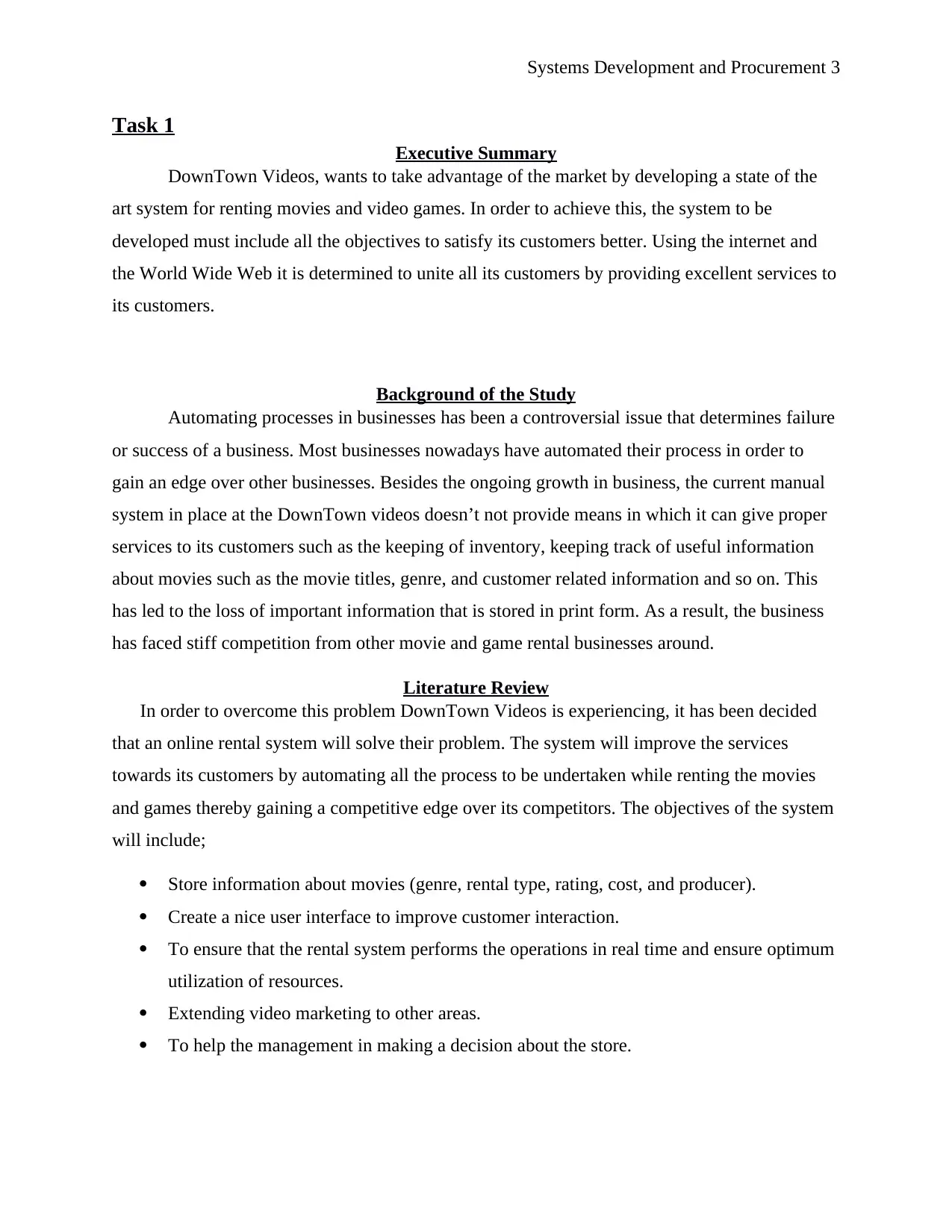
Systems Development and Procurement 3
Task 1
Executive Summary
DownTown Videos, wants to take advantage of the market by developing a state of the
art system for renting movies and video games. In order to achieve this, the system to be
developed must include all the objectives to satisfy its customers better. Using the internet and
the World Wide Web it is determined to unite all its customers by providing excellent services to
its customers.
Background of the Study
Automating processes in businesses has been a controversial issue that determines failure
or success of a business. Most businesses nowadays have automated their process in order to
gain an edge over other businesses. Besides the ongoing growth in business, the current manual
system in place at the DownTown videos doesn’t not provide means in which it can give proper
services to its customers such as the keeping of inventory, keeping track of useful information
about movies such as the movie titles, genre, and customer related information and so on. This
has led to the loss of important information that is stored in print form. As a result, the business
has faced stiff competition from other movie and game rental businesses around.
Literature Review
In order to overcome this problem DownTown Videos is experiencing, it has been decided
that an online rental system will solve their problem. The system will improve the services
towards its customers by automating all the process to be undertaken while renting the movies
and games thereby gaining a competitive edge over its competitors. The objectives of the system
will include;
Store information about movies (genre, rental type, rating, cost, and producer).
Create a nice user interface to improve customer interaction.
To ensure that the rental system performs the operations in real time and ensure optimum
utilization of resources.
Extending video marketing to other areas.
To help the management in making a decision about the store.
Task 1
Executive Summary
DownTown Videos, wants to take advantage of the market by developing a state of the
art system for renting movies and video games. In order to achieve this, the system to be
developed must include all the objectives to satisfy its customers better. Using the internet and
the World Wide Web it is determined to unite all its customers by providing excellent services to
its customers.
Background of the Study
Automating processes in businesses has been a controversial issue that determines failure
or success of a business. Most businesses nowadays have automated their process in order to
gain an edge over other businesses. Besides the ongoing growth in business, the current manual
system in place at the DownTown videos doesn’t not provide means in which it can give proper
services to its customers such as the keeping of inventory, keeping track of useful information
about movies such as the movie titles, genre, and customer related information and so on. This
has led to the loss of important information that is stored in print form. As a result, the business
has faced stiff competition from other movie and game rental businesses around.
Literature Review
In order to overcome this problem DownTown Videos is experiencing, it has been decided
that an online rental system will solve their problem. The system will improve the services
towards its customers by automating all the process to be undertaken while renting the movies
and games thereby gaining a competitive edge over its competitors. The objectives of the system
will include;
Store information about movies (genre, rental type, rating, cost, and producer).
Create a nice user interface to improve customer interaction.
To ensure that the rental system performs the operations in real time and ensure optimum
utilization of resources.
Extending video marketing to other areas.
To help the management in making a decision about the store.
⊘ This is a preview!⊘
Do you want full access?
Subscribe today to unlock all pages.

Trusted by 1+ million students worldwide
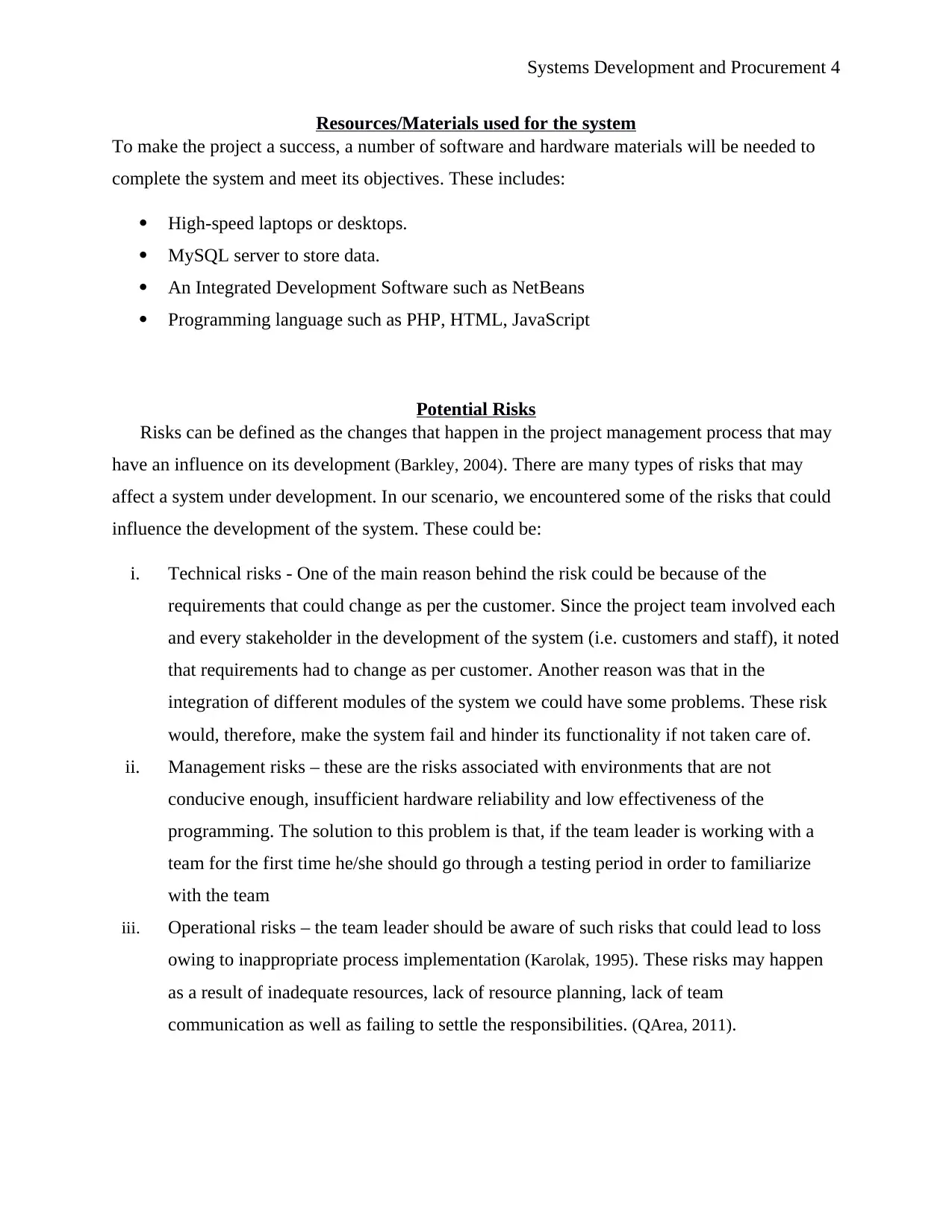
Systems Development and Procurement 4
Resources/Materials used for the system
To make the project a success, a number of software and hardware materials will be needed to
complete the system and meet its objectives. These includes:
High-speed laptops or desktops.
MySQL server to store data.
An Integrated Development Software such as NetBeans
Programming language such as PHP, HTML, JavaScript
Potential Risks
Risks can be defined as the changes that happen in the project management process that may
have an influence on its development (Barkley, 2004). There are many types of risks that may
affect a system under development. In our scenario, we encountered some of the risks that could
influence the development of the system. These could be:
i. Technical risks - One of the main reason behind the risk could be because of the
requirements that could change as per the customer. Since the project team involved each
and every stakeholder in the development of the system (i.e. customers and staff), it noted
that requirements had to change as per customer. Another reason was that in the
integration of different modules of the system we could have some problems. These risk
would, therefore, make the system fail and hinder its functionality if not taken care of.
ii. Management risks – these are the risks associated with environments that are not
conducive enough, insufficient hardware reliability and low effectiveness of the
programming. The solution to this problem is that, if the team leader is working with a
team for the first time he/she should go through a testing period in order to familiarize
with the team
iii. Operational risks – the team leader should be aware of such risks that could lead to loss
owing to inappropriate process implementation (Karolak, 1995). These risks may happen
as a result of inadequate resources, lack of resource planning, lack of team
communication as well as failing to settle the responsibilities. (QArea, 2011).
Resources/Materials used for the system
To make the project a success, a number of software and hardware materials will be needed to
complete the system and meet its objectives. These includes:
High-speed laptops or desktops.
MySQL server to store data.
An Integrated Development Software such as NetBeans
Programming language such as PHP, HTML, JavaScript
Potential Risks
Risks can be defined as the changes that happen in the project management process that may
have an influence on its development (Barkley, 2004). There are many types of risks that may
affect a system under development. In our scenario, we encountered some of the risks that could
influence the development of the system. These could be:
i. Technical risks - One of the main reason behind the risk could be because of the
requirements that could change as per the customer. Since the project team involved each
and every stakeholder in the development of the system (i.e. customers and staff), it noted
that requirements had to change as per customer. Another reason was that in the
integration of different modules of the system we could have some problems. These risk
would, therefore, make the system fail and hinder its functionality if not taken care of.
ii. Management risks – these are the risks associated with environments that are not
conducive enough, insufficient hardware reliability and low effectiveness of the
programming. The solution to this problem is that, if the team leader is working with a
team for the first time he/she should go through a testing period in order to familiarize
with the team
iii. Operational risks – the team leader should be aware of such risks that could lead to loss
owing to inappropriate process implementation (Karolak, 1995). These risks may happen
as a result of inadequate resources, lack of resource planning, lack of team
communication as well as failing to settle the responsibilities. (QArea, 2011).
Paraphrase This Document
Need a fresh take? Get an instant paraphrase of this document with our AI Paraphraser
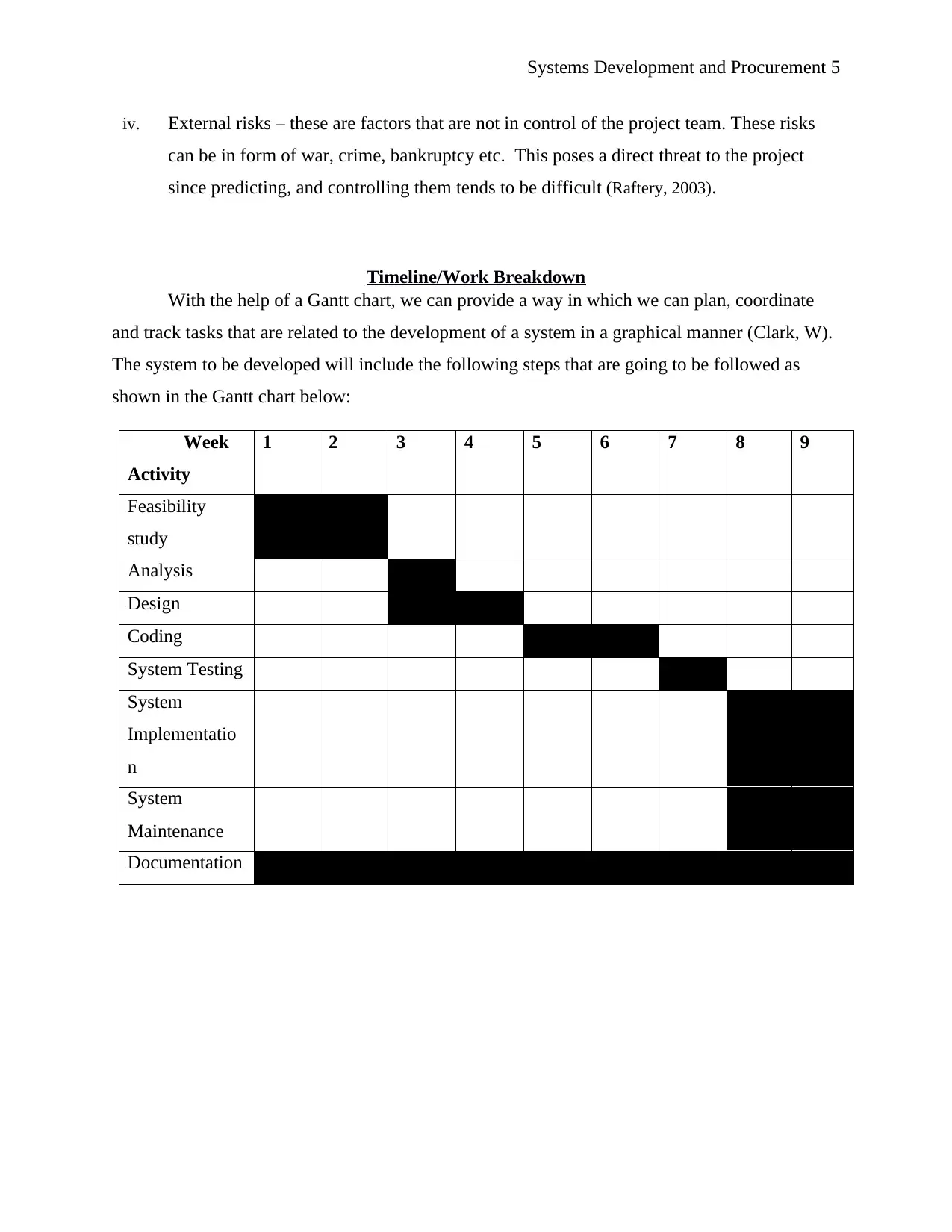
Systems Development and Procurement 5
iv. External risks – these are factors that are not in control of the project team. These risks
can be in form of war, crime, bankruptcy etc. This poses a direct threat to the project
since predicting, and controlling them tends to be difficult (Raftery, 2003).
Timeline/Work Breakdown
With the help of a Gantt chart, we can provide a way in which we can plan, coordinate
and track tasks that are related to the development of a system in a graphical manner (Clark, W).
The system to be developed will include the following steps that are going to be followed as
shown in the Gantt chart below:
Week
Activity
1 2 3 4 5 6 7 8 9
Feasibility
study
Analysis
Design
Coding
System Testing
System
Implementatio
n
System
Maintenance
Documentation
iv. External risks – these are factors that are not in control of the project team. These risks
can be in form of war, crime, bankruptcy etc. This poses a direct threat to the project
since predicting, and controlling them tends to be difficult (Raftery, 2003).
Timeline/Work Breakdown
With the help of a Gantt chart, we can provide a way in which we can plan, coordinate
and track tasks that are related to the development of a system in a graphical manner (Clark, W).
The system to be developed will include the following steps that are going to be followed as
shown in the Gantt chart below:
Week
Activity
1 2 3 4 5 6 7 8 9
Feasibility
study
Analysis
Design
Coding
System Testing
System
Implementatio
n
System
Maintenance
Documentation
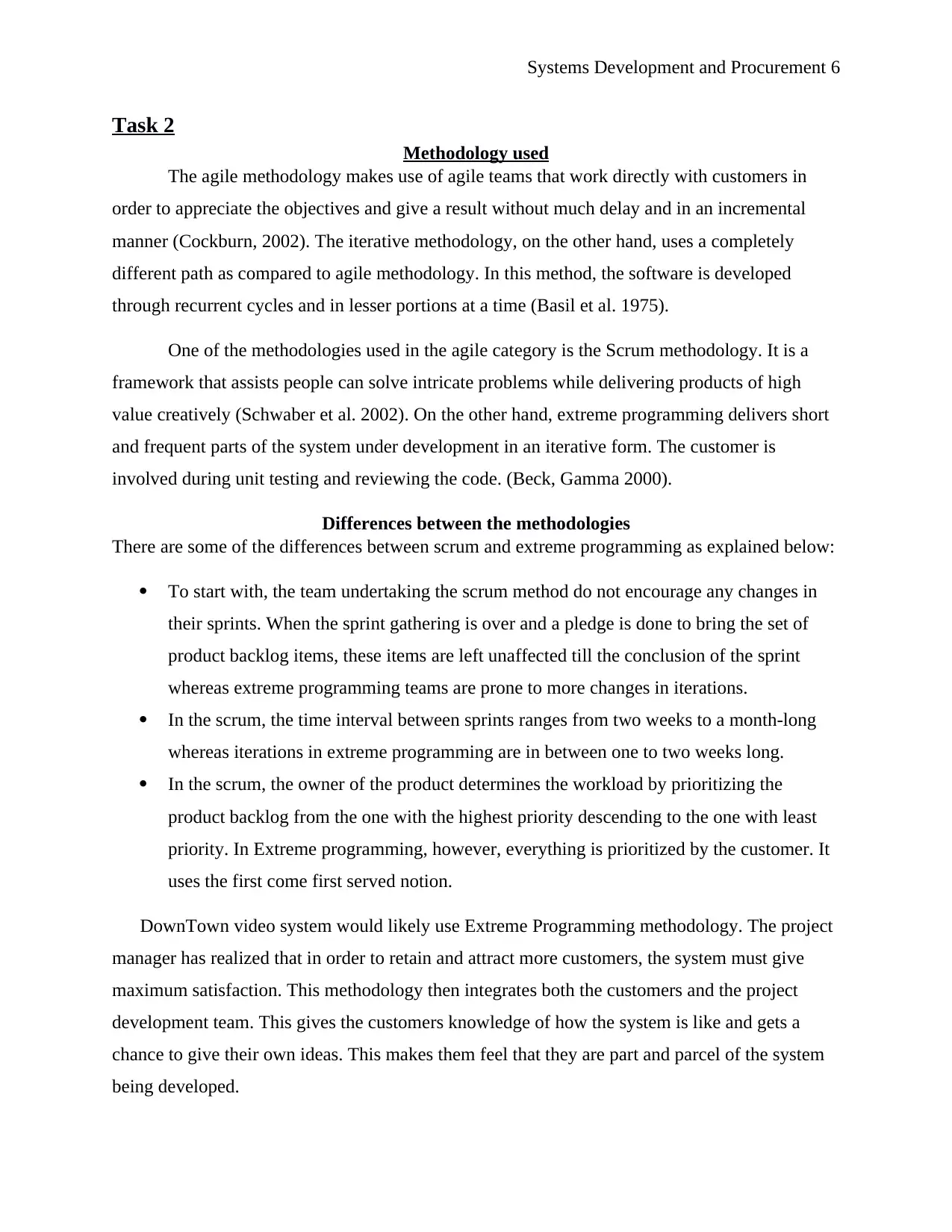
Systems Development and Procurement 6
Task 2
Methodology used
The agile methodology makes use of agile teams that work directly with customers in
order to appreciate the objectives and give a result without much delay and in an incremental
manner (Cockburn, 2002). The iterative methodology, on the other hand, uses a completely
different path as compared to agile methodology. In this method, the software is developed
through recurrent cycles and in lesser portions at a time (Basil et al. 1975).
One of the methodologies used in the agile category is the Scrum methodology. It is a
framework that assists people can solve intricate problems while delivering products of high
value creatively (Schwaber et al. 2002). On the other hand, extreme programming delivers short
and frequent parts of the system under development in an iterative form. The customer is
involved during unit testing and reviewing the code. (Beck, Gamma 2000).
Differences between the methodologies
There are some of the differences between scrum and extreme programming as explained below:
To start with, the team undertaking the scrum method do not encourage any changes in
their sprints. When the sprint gathering is over and a pledge is done to bring the set of
product backlog items, these items are left unaffected till the conclusion of the sprint
whereas extreme programming teams are prone to more changes in iterations.
In the scrum, the time interval between sprints ranges from two weeks to a month-long
whereas iterations in extreme programming are in between one to two weeks long.
In the scrum, the owner of the product determines the workload by prioritizing the
product backlog from the one with the highest priority descending to the one with least
priority. In Extreme programming, however, everything is prioritized by the customer. It
uses the first come first served notion.
DownTown video system would likely use Extreme Programming methodology. The project
manager has realized that in order to retain and attract more customers, the system must give
maximum satisfaction. This methodology then integrates both the customers and the project
development team. This gives the customers knowledge of how the system is like and gets a
chance to give their own ideas. This makes them feel that they are part and parcel of the system
being developed.
Task 2
Methodology used
The agile methodology makes use of agile teams that work directly with customers in
order to appreciate the objectives and give a result without much delay and in an incremental
manner (Cockburn, 2002). The iterative methodology, on the other hand, uses a completely
different path as compared to agile methodology. In this method, the software is developed
through recurrent cycles and in lesser portions at a time (Basil et al. 1975).
One of the methodologies used in the agile category is the Scrum methodology. It is a
framework that assists people can solve intricate problems while delivering products of high
value creatively (Schwaber et al. 2002). On the other hand, extreme programming delivers short
and frequent parts of the system under development in an iterative form. The customer is
involved during unit testing and reviewing the code. (Beck, Gamma 2000).
Differences between the methodologies
There are some of the differences between scrum and extreme programming as explained below:
To start with, the team undertaking the scrum method do not encourage any changes in
their sprints. When the sprint gathering is over and a pledge is done to bring the set of
product backlog items, these items are left unaffected till the conclusion of the sprint
whereas extreme programming teams are prone to more changes in iterations.
In the scrum, the time interval between sprints ranges from two weeks to a month-long
whereas iterations in extreme programming are in between one to two weeks long.
In the scrum, the owner of the product determines the workload by prioritizing the
product backlog from the one with the highest priority descending to the one with least
priority. In Extreme programming, however, everything is prioritized by the customer. It
uses the first come first served notion.
DownTown video system would likely use Extreme Programming methodology. The project
manager has realized that in order to retain and attract more customers, the system must give
maximum satisfaction. This methodology then integrates both the customers and the project
development team. This gives the customers knowledge of how the system is like and gets a
chance to give their own ideas. This makes them feel that they are part and parcel of the system
being developed.
⊘ This is a preview!⊘
Do you want full access?
Subscribe today to unlock all pages.

Trusted by 1+ million students worldwide
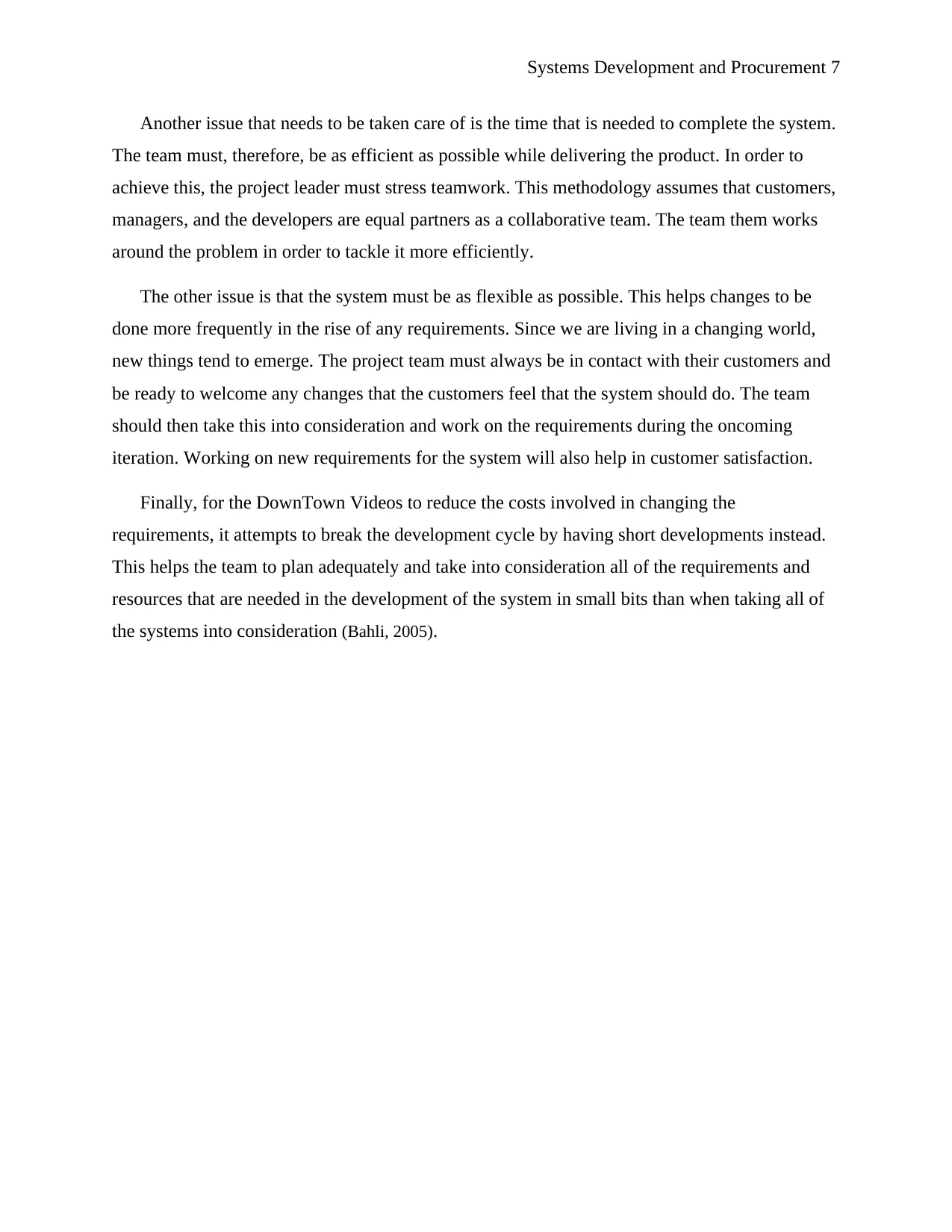
Systems Development and Procurement 7
Another issue that needs to be taken care of is the time that is needed to complete the system.
The team must, therefore, be as efficient as possible while delivering the product. In order to
achieve this, the project leader must stress teamwork. This methodology assumes that customers,
managers, and the developers are equal partners as a collaborative team. The team them works
around the problem in order to tackle it more efficiently.
The other issue is that the system must be as flexible as possible. This helps changes to be
done more frequently in the rise of any requirements. Since we are living in a changing world,
new things tend to emerge. The project team must always be in contact with their customers and
be ready to welcome any changes that the customers feel that the system should do. The team
should then take this into consideration and work on the requirements during the oncoming
iteration. Working on new requirements for the system will also help in customer satisfaction.
Finally, for the DownTown Videos to reduce the costs involved in changing the
requirements, it attempts to break the development cycle by having short developments instead.
This helps the team to plan adequately and take into consideration all of the requirements and
resources that are needed in the development of the system in small bits than when taking all of
the systems into consideration (Bahli, 2005).
Another issue that needs to be taken care of is the time that is needed to complete the system.
The team must, therefore, be as efficient as possible while delivering the product. In order to
achieve this, the project leader must stress teamwork. This methodology assumes that customers,
managers, and the developers are equal partners as a collaborative team. The team them works
around the problem in order to tackle it more efficiently.
The other issue is that the system must be as flexible as possible. This helps changes to be
done more frequently in the rise of any requirements. Since we are living in a changing world,
new things tend to emerge. The project team must always be in contact with their customers and
be ready to welcome any changes that the customers feel that the system should do. The team
should then take this into consideration and work on the requirements during the oncoming
iteration. Working on new requirements for the system will also help in customer satisfaction.
Finally, for the DownTown Videos to reduce the costs involved in changing the
requirements, it attempts to break the development cycle by having short developments instead.
This helps the team to plan adequately and take into consideration all of the requirements and
resources that are needed in the development of the system in small bits than when taking all of
the systems into consideration (Bahli, 2005).
Paraphrase This Document
Need a fresh take? Get an instant paraphrase of this document with our AI Paraphraser
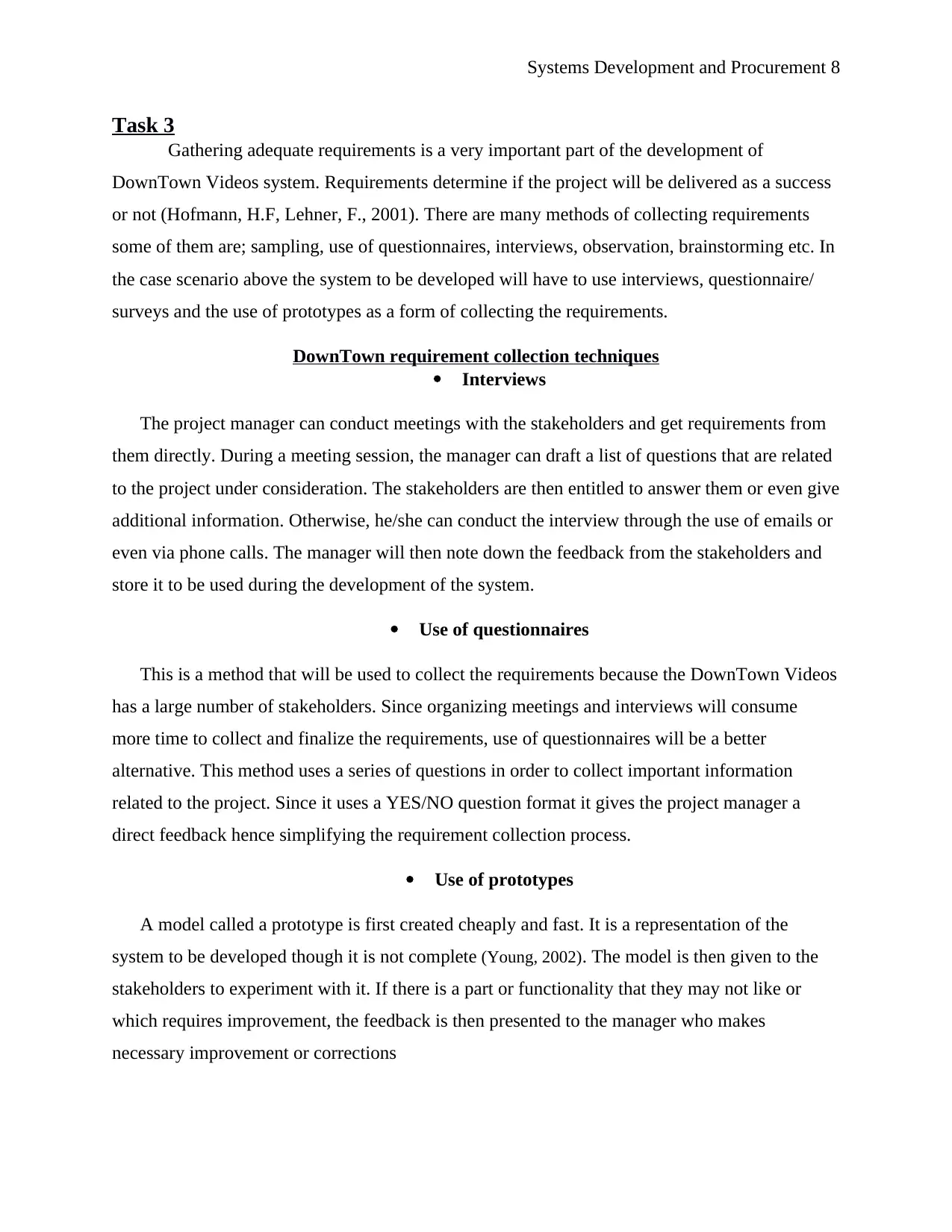
Systems Development and Procurement 8
Task 3
Gathering adequate requirements is a very important part of the development of
DownTown Videos system. Requirements determine if the project will be delivered as a success
or not (Hofmann, H.F, Lehner, F., 2001). There are many methods of collecting requirements
some of them are; sampling, use of questionnaires, interviews, observation, brainstorming etc. In
the case scenario above the system to be developed will have to use interviews, questionnaire/
surveys and the use of prototypes as a form of collecting the requirements.
DownTown requirement collection techniques
Interviews
The project manager can conduct meetings with the stakeholders and get requirements from
them directly. During a meeting session, the manager can draft a list of questions that are related
to the project under consideration. The stakeholders are then entitled to answer them or even give
additional information. Otherwise, he/she can conduct the interview through the use of emails or
even via phone calls. The manager will then note down the feedback from the stakeholders and
store it to be used during the development of the system.
Use of questionnaires
This is a method that will be used to collect the requirements because the DownTown Videos
has a large number of stakeholders. Since organizing meetings and interviews will consume
more time to collect and finalize the requirements, use of questionnaires will be a better
alternative. This method uses a series of questions in order to collect important information
related to the project. Since it uses a YES/NO question format it gives the project manager a
direct feedback hence simplifying the requirement collection process.
Use of prototypes
A model called a prototype is first created cheaply and fast. It is a representation of the
system to be developed though it is not complete (Young, 2002). The model is then given to the
stakeholders to experiment with it. If there is a part or functionality that they may not like or
which requires improvement, the feedback is then presented to the manager who makes
necessary improvement or corrections
Task 3
Gathering adequate requirements is a very important part of the development of
DownTown Videos system. Requirements determine if the project will be delivered as a success
or not (Hofmann, H.F, Lehner, F., 2001). There are many methods of collecting requirements
some of them are; sampling, use of questionnaires, interviews, observation, brainstorming etc. In
the case scenario above the system to be developed will have to use interviews, questionnaire/
surveys and the use of prototypes as a form of collecting the requirements.
DownTown requirement collection techniques
Interviews
The project manager can conduct meetings with the stakeholders and get requirements from
them directly. During a meeting session, the manager can draft a list of questions that are related
to the project under consideration. The stakeholders are then entitled to answer them or even give
additional information. Otherwise, he/she can conduct the interview through the use of emails or
even via phone calls. The manager will then note down the feedback from the stakeholders and
store it to be used during the development of the system.
Use of questionnaires
This is a method that will be used to collect the requirements because the DownTown Videos
has a large number of stakeholders. Since organizing meetings and interviews will consume
more time to collect and finalize the requirements, use of questionnaires will be a better
alternative. This method uses a series of questions in order to collect important information
related to the project. Since it uses a YES/NO question format it gives the project manager a
direct feedback hence simplifying the requirement collection process.
Use of prototypes
A model called a prototype is first created cheaply and fast. It is a representation of the
system to be developed though it is not complete (Young, 2002). The model is then given to the
stakeholders to experiment with it. If there is a part or functionality that they may not like or
which requires improvement, the feedback is then presented to the manager who makes
necessary improvement or corrections
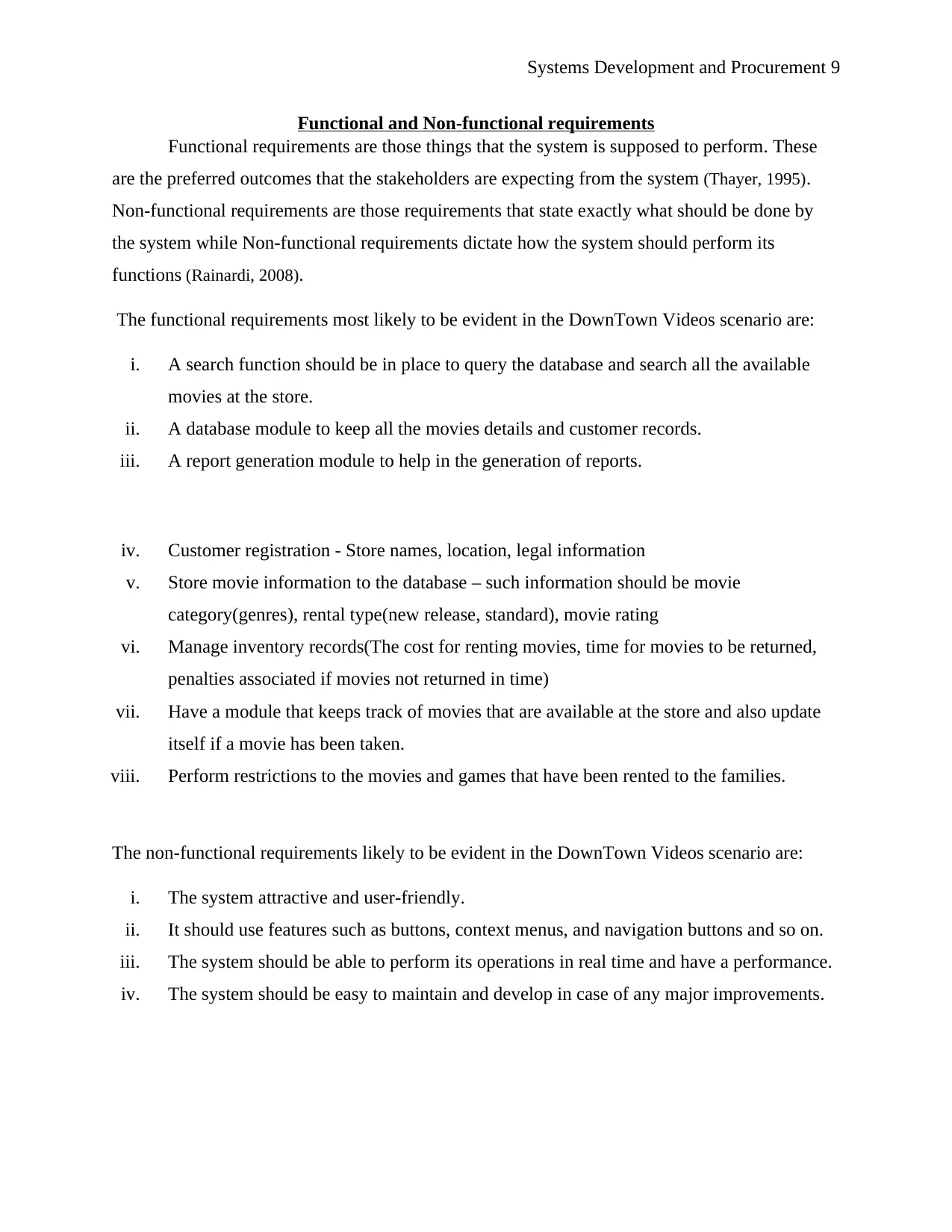
Systems Development and Procurement 9
Functional and Non-functional requirements
Functional requirements are those things that the system is supposed to perform. These
are the preferred outcomes that the stakeholders are expecting from the system (Thayer, 1995).
Non-functional requirements are those requirements that state exactly what should be done by
the system while Non-functional requirements dictate how the system should perform its
functions (Rainardi, 2008).
The functional requirements most likely to be evident in the DownTown Videos scenario are:
i. A search function should be in place to query the database and search all the available
movies at the store.
ii. A database module to keep all the movies details and customer records.
iii. A report generation module to help in the generation of reports.
iv. Customer registration - Store names, location, legal information
v. Store movie information to the database – such information should be movie
category(genres), rental type(new release, standard), movie rating
vi. Manage inventory records(The cost for renting movies, time for movies to be returned,
penalties associated if movies not returned in time)
vii. Have a module that keeps track of movies that are available at the store and also update
itself if a movie has been taken.
viii. Perform restrictions to the movies and games that have been rented to the families.
The non-functional requirements likely to be evident in the DownTown Videos scenario are:
i. The system attractive and user-friendly.
ii. It should use features such as buttons, context menus, and navigation buttons and so on.
iii. The system should be able to perform its operations in real time and have a performance.
iv. The system should be easy to maintain and develop in case of any major improvements.
Functional and Non-functional requirements
Functional requirements are those things that the system is supposed to perform. These
are the preferred outcomes that the stakeholders are expecting from the system (Thayer, 1995).
Non-functional requirements are those requirements that state exactly what should be done by
the system while Non-functional requirements dictate how the system should perform its
functions (Rainardi, 2008).
The functional requirements most likely to be evident in the DownTown Videos scenario are:
i. A search function should be in place to query the database and search all the available
movies at the store.
ii. A database module to keep all the movies details and customer records.
iii. A report generation module to help in the generation of reports.
iv. Customer registration - Store names, location, legal information
v. Store movie information to the database – such information should be movie
category(genres), rental type(new release, standard), movie rating
vi. Manage inventory records(The cost for renting movies, time for movies to be returned,
penalties associated if movies not returned in time)
vii. Have a module that keeps track of movies that are available at the store and also update
itself if a movie has been taken.
viii. Perform restrictions to the movies and games that have been rented to the families.
The non-functional requirements likely to be evident in the DownTown Videos scenario are:
i. The system attractive and user-friendly.
ii. It should use features such as buttons, context menus, and navigation buttons and so on.
iii. The system should be able to perform its operations in real time and have a performance.
iv. The system should be easy to maintain and develop in case of any major improvements.
⊘ This is a preview!⊘
Do you want full access?
Subscribe today to unlock all pages.

Trusted by 1+ million students worldwide
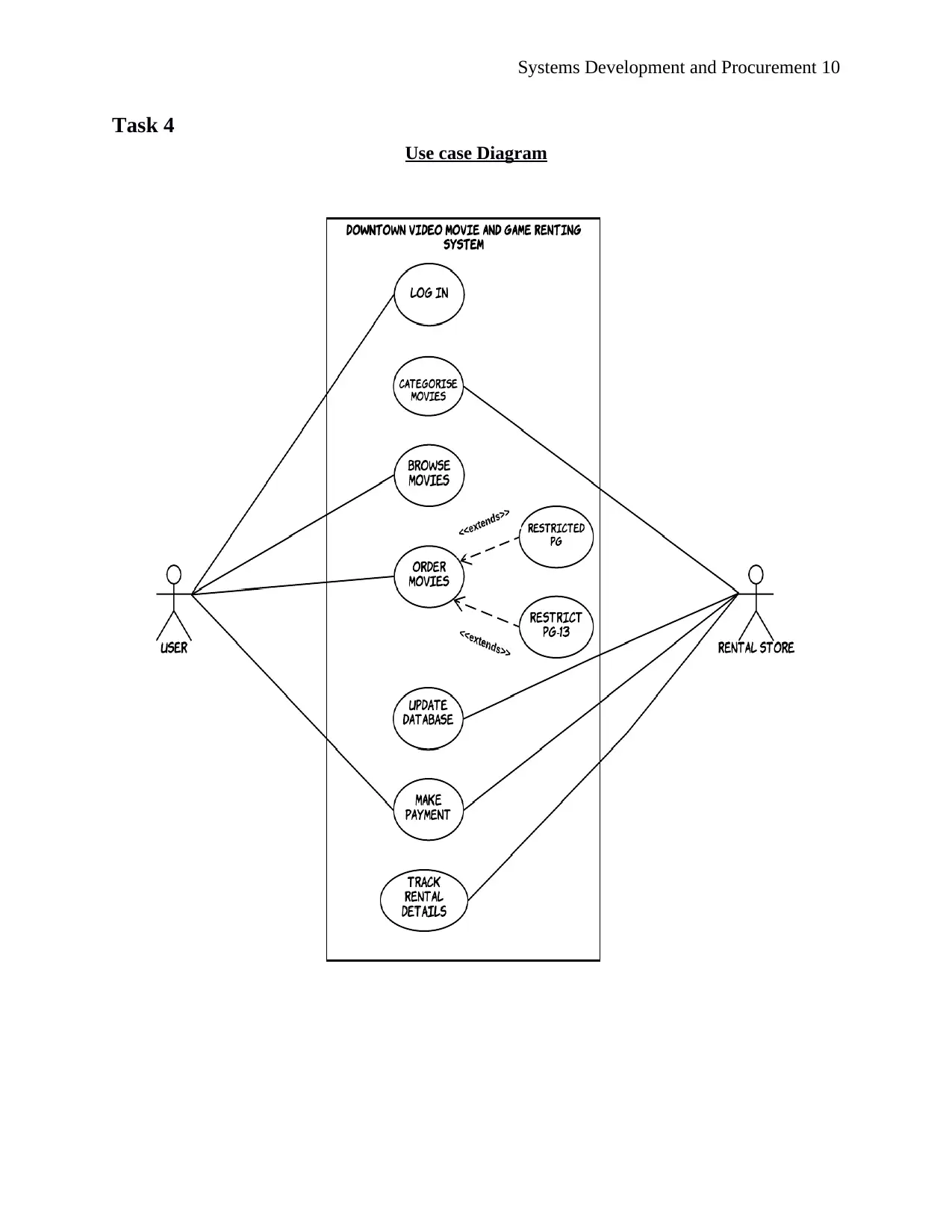
Systems Development and Procurement 10
Task 4
Use case Diagram
Task 4
Use case Diagram
Paraphrase This Document
Need a fresh take? Get an instant paraphrase of this document with our AI Paraphraser
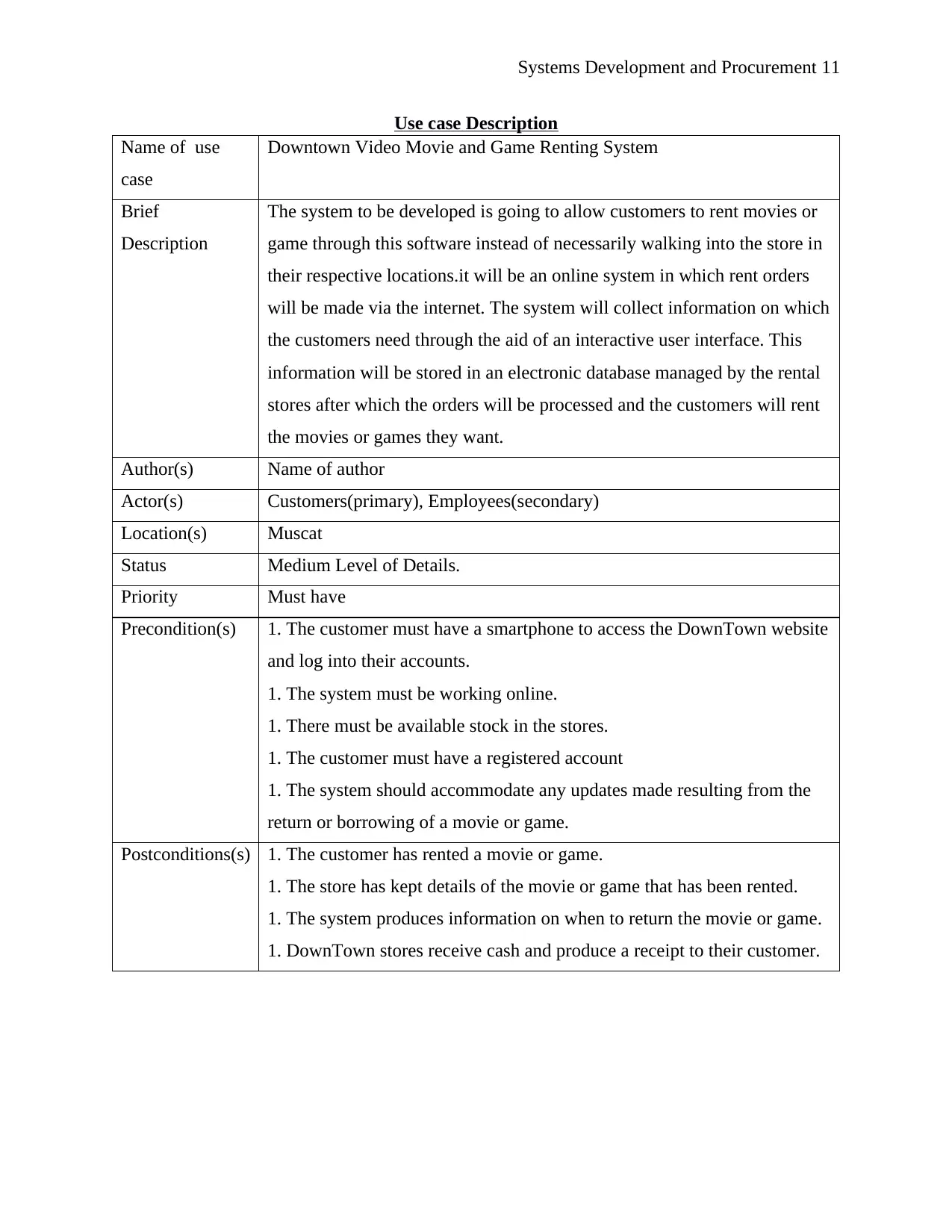
Systems Development and Procurement 11
Use case Description
Name of use
case
Downtown Video Movie and Game Renting System
Brief
Description
The system to be developed is going to allow customers to rent movies or
game through this software instead of necessarily walking into the store in
their respective locations.it will be an online system in which rent orders
will be made via the internet. The system will collect information on which
the customers need through the aid of an interactive user interface. This
information will be stored in an electronic database managed by the rental
stores after which the orders will be processed and the customers will rent
the movies or games they want.
Author(s) Name of author
Actor(s) Customers(primary), Employees(secondary)
Location(s) Muscat
Status Medium Level of Details.
Priority Must have
Precondition(s) 1. The customer must have a smartphone to access the DownTown website
and log into their accounts.
1. The system must be working online.
1. There must be available stock in the stores.
1. The customer must have a registered account
1. The system should accommodate any updates made resulting from the
return or borrowing of a movie or game.
Postconditions(s) 1. The customer has rented a movie or game.
1. The store has kept details of the movie or game that has been rented.
1. The system produces information on when to return the movie or game.
1. DownTown stores receive cash and produce a receipt to their customer.
Use case Description
Name of use
case
Downtown Video Movie and Game Renting System
Brief
Description
The system to be developed is going to allow customers to rent movies or
game through this software instead of necessarily walking into the store in
their respective locations.it will be an online system in which rent orders
will be made via the internet. The system will collect information on which
the customers need through the aid of an interactive user interface. This
information will be stored in an electronic database managed by the rental
stores after which the orders will be processed and the customers will rent
the movies or games they want.
Author(s) Name of author
Actor(s) Customers(primary), Employees(secondary)
Location(s) Muscat
Status Medium Level of Details.
Priority Must have
Precondition(s) 1. The customer must have a smartphone to access the DownTown website
and log into their accounts.
1. The system must be working online.
1. There must be available stock in the stores.
1. The customer must have a registered account
1. The system should accommodate any updates made resulting from the
return or borrowing of a movie or game.
Postconditions(s) 1. The customer has rented a movie or game.
1. The store has kept details of the movie or game that has been rented.
1. The system produces information on when to return the movie or game.
1. DownTown stores receive cash and produce a receipt to their customer.
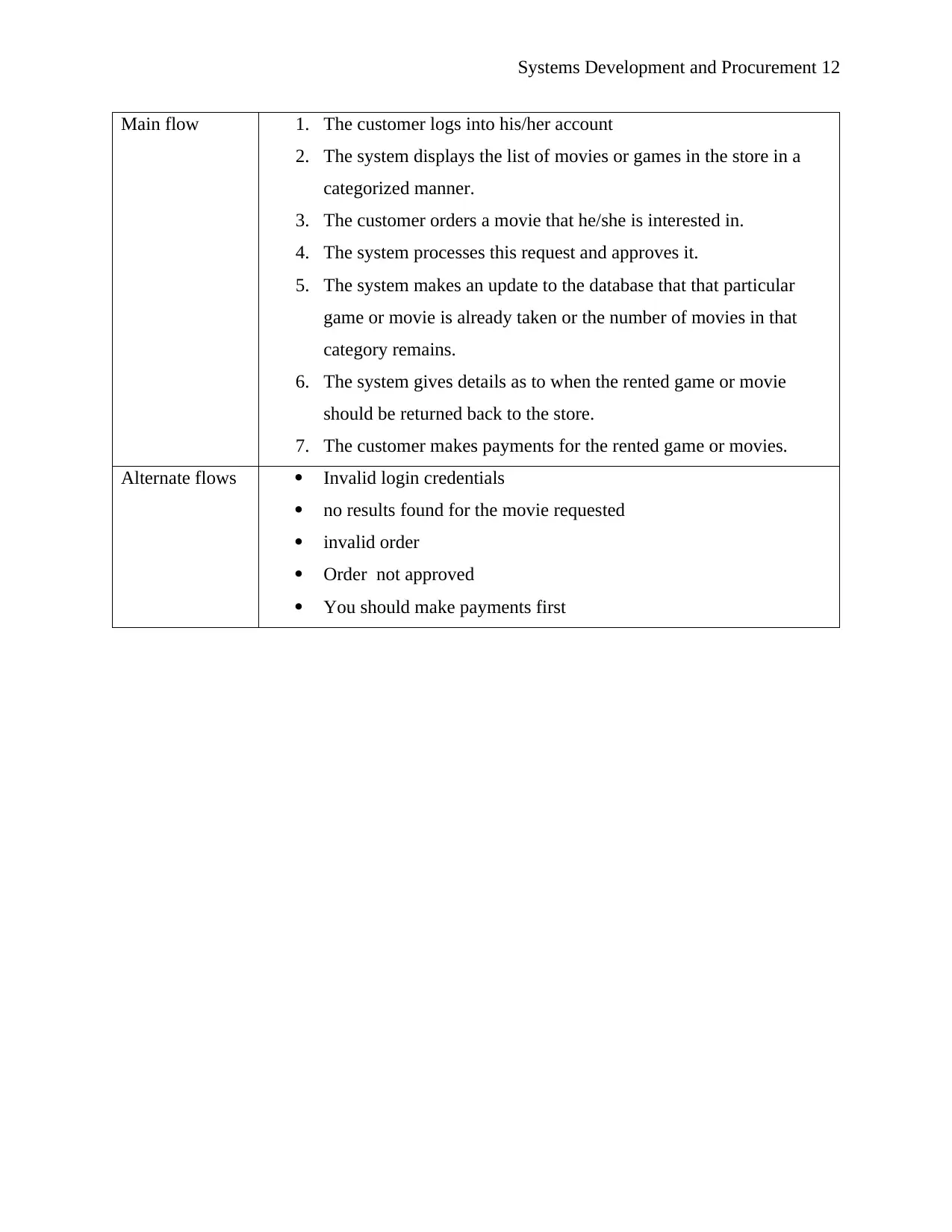
Systems Development and Procurement 12
Main flow 1. The customer logs into his/her account
2. The system displays the list of movies or games in the store in a
categorized manner.
3. The customer orders a movie that he/she is interested in.
4. The system processes this request and approves it.
5. The system makes an update to the database that that particular
game or movie is already taken or the number of movies in that
category remains.
6. The system gives details as to when the rented game or movie
should be returned back to the store.
7. The customer makes payments for the rented game or movies.
Alternate flows Invalid login credentials
no results found for the movie requested
invalid order
Order not approved
You should make payments first
Main flow 1. The customer logs into his/her account
2. The system displays the list of movies or games in the store in a
categorized manner.
3. The customer orders a movie that he/she is interested in.
4. The system processes this request and approves it.
5. The system makes an update to the database that that particular
game or movie is already taken or the number of movies in that
category remains.
6. The system gives details as to when the rented game or movie
should be returned back to the store.
7. The customer makes payments for the rented game or movies.
Alternate flows Invalid login credentials
no results found for the movie requested
invalid order
Order not approved
You should make payments first
⊘ This is a preview!⊘
Do you want full access?
Subscribe today to unlock all pages.

Trusted by 1+ million students worldwide
1 out of 21
Related Documents
Your All-in-One AI-Powered Toolkit for Academic Success.
+13062052269
info@desklib.com
Available 24*7 on WhatsApp / Email
![[object Object]](/_next/static/media/star-bottom.7253800d.svg)
Unlock your academic potential
Copyright © 2020–2025 A2Z Services. All Rights Reserved. Developed and managed by ZUCOL.





